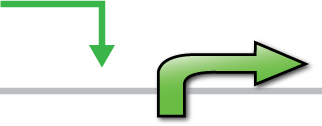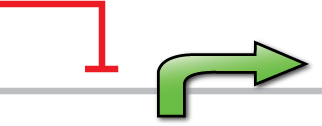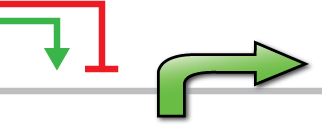Difference between revisions of "Help:Promoters/Regulation"
(New page: Regulation in the context of a promoter means the ability to affect the transcriptional activity of that promoter. While the activity of all promoters is often affected by the availabilit...) |
m |
||
| (3 intermediate revisions by 2 users not shown) | |||
| Line 1: | Line 1: | ||
| − | Regulation in the context of a promoter means the ability to affect the transcriptional activity of that promoter. While the activity of all promoters is often affected by the availability of [[Help:Promoters/RNA | + | [[Category:Regulatory]] |
| + | Regulation in the context of a promoter means the ability to affect the transcriptional activity of that promoter. While the activity of all promoters is often affected by the availability of [[Help:Promoters/RNA polymerases|RNA Polymerase]], regulation normally refers to the effects of transcription factors (proteins that can affect promoter activity) and sometimes by σ factors (proteins that alter the specificity of an RNA Polymerase for particular sequences). A promoter can be regulated in a variety of ways - | ||
| + | [[Image:ConstitutivePromoter.png|right|200px]] | ||
| + | #'''Constitutive:''' A constitutive promoter is one that is not regulated by any transcription factors. The activity of such a promoter may be affected by the levels of RNA Polymerase or particular σ factors.<br style="clear:both" /> | ||
| + | [[Image:PositivePromoter.png|right|200px]] | ||
| + | #'''Positively regulated:''' A positively regulated promoter has increasing activity as the level of some transcription factor (known as an activator) increases.<br style="clear:both" /> | ||
| + | [[Image:NegativePromoter.png|right|200px]] | ||
| + | #'''Negatively regulated:''' A negatively regulated promoter has decreasing activity as the level of some transcription factor (known as a repressor) increases.<br style="clear:both" /> | ||
| + | [[Image:MultiplePromoter.png|right|200px]] | ||
| + | #'''Multi-regulated:''' A multi-regulated promoter has an activity that is affected, either positively or negatively by the levels of multiple transcription factors (either activators or repressors).<br style="clear:both" /> | ||
| − | |||
| − | |||
| − | |||
| − | |||
| − | Note: promoters are often referred to as being '''inducible'''. This normally means that there is a repressor that is always present, reducing the activity of the promoter. The activity of the promoter can be "induced" by adding a small molecule that inactivates the repressor (see <partinfo>BBa_I0500</partinfo> for an example). Alternatively, an inducible promoter can mean a promoter that has low activity in the absence of an activator protein, and that activator protein only becomes active when it is bound to a small molecule that must be added exogenously (see <partinfo>BBa_F2620</partinfo> for an example). From the above, you can see that an inducible promoter can either be positively or negatively regulated by | + | Note: promoters are often referred to as being '''inducible'''. This normally means that there is a repressor that is always present, reducing the activity of the promoter. The activity of the promoter can be "induced" by adding a small molecule that inactivates the repressor (see <partinfo>BBa_I0500</partinfo> for an example). Alternatively, an inducible promoter can mean a promoter that has low activity in the absence of an activator protein, and that activator protein only becomes active when it is bound to a small molecule that must be added exogenously (see <partinfo>BBa_F2620</partinfo> for an example). From the above, you can see that an inducible promoter can either be positively or negatively regulated by a transcription factor, so in the interests of clarity, we generally classify promoters as being positively or negatively regulated in the registry catalog. |
Latest revision as of 21:49, 20 July 2017
Regulation in the context of a promoter means the ability to affect the transcriptional activity of that promoter. While the activity of all promoters is often affected by the availability of RNA Polymerase, regulation normally refers to the effects of transcription factors (proteins that can affect promoter activity) and sometimes by σ factors (proteins that alter the specificity of an RNA Polymerase for particular sequences). A promoter can be regulated in a variety of ways -
- Constitutive: A constitutive promoter is one that is not regulated by any transcription factors. The activity of such a promoter may be affected by the levels of RNA Polymerase or particular σ factors.
- Positively regulated: A positively regulated promoter has increasing activity as the level of some transcription factor (known as an activator) increases.
- Negatively regulated: A negatively regulated promoter has decreasing activity as the level of some transcription factor (known as a repressor) increases.
- Multi-regulated: A multi-regulated promoter has an activity that is affected, either positively or negatively by the levels of multiple transcription factors (either activators or repressors).
Note: promoters are often referred to as being inducible. This normally means that there is a repressor that is always present, reducing the activity of the promoter. The activity of the promoter can be "induced" by adding a small molecule that inactivates the repressor (see BBa_I0500 for an example). Alternatively, an inducible promoter can mean a promoter that has low activity in the absence of an activator protein, and that activator protein only becomes active when it is bound to a small molecule that must be added exogenously (see BBa_F2620 for an example). From the above, you can see that an inducible promoter can either be positively or negatively regulated by a transcription factor, so in the interests of clarity, we generally classify promoters as being positively or negatively regulated in the registry catalog.




